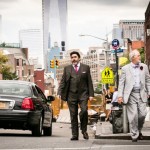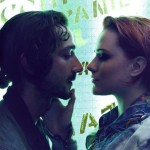Funny Face, Director Stanley Donen’s delightful musical romcom from 1957, is not as dated as it may seem at first glance. The costumes by Edith Head and Givenchy might not be today’s fashion, but they look surprisingly fresh and still take your breath away.
And if today’s emaciated waif-models can look in the mirror and think they’re old and fat, then perhaps Audrey Hepburn’s character, Jo Stockon, can agree with fashion photographer Dick Avery (Fred Astaire) that she has a funny face. And who today would bat one of Hepburn’s melting-pool eyes at a 58-year-old celebrity photographer marrying a 28-year-old supermodel?
Funny Face has a new print from Park Circus and is showing at the BFI and selected cinemas nationwide. This distributor has been giving us a reason to return to our old favourites, or fill in the gaps of must see films from cinema history.
Funny Face is loosely based on George and Ira Gershwin’s 1927 musical of the same title and contains several of their songs, although the plot is closer to that of the musical Wedding Bells. The script is by Leonard Gershe (40 Carats, Butterflies are Free) and Adolph Deutsch, who had won an Oscar in 1955 for his work on Oklahoma!, wrote the main score.
In the only collaboration between Hepburn, a trained ballet dancer at the beginning of her short, but illustrious career, and Astaire, heading toward the end of his long career, Astaire plays a fashion photographer modelled after Richard Avedon.
The real Avedon contributed the opening title sequence and several of Astaire/Avery’s photographs in the film. The son of Jewish immigrants who rose to fame at Harpers Bazaar, Avedon went on to shoot almost all of the influential covers of Vogue Magazine from 1973 to 1988.
During a photo shoot in Greenwich Village, Avery falls for sales assistant Jo (Hepburn), whose book shop they have taken over. Despite her dowdy clothes and gloomy manner, Avery convinces his pushy fashion magazine boss (Kay Thompson) that Jo has what it takes to be the new look for the magazine’s big Paris campaign.
Jo reluctantly agrees to be transformed into a fashion icon because of the free trip to Paris. It’s in Paris that her idol, literary philosopher of the day Emile Flostre (Michel Auclair), lectures on Empathicalism to adoring academics, intellectuals and students.
In an unforgettable sequence Avery takes Jo all around Paris where she poses in gorgeous gowns at famous landmarks. They develop feelings for one another that turn to jealousy on Avery’s part when Jo (rather unprofessionally) skips a catwalk appearance to meet Flostre. But Jo is soon disillusioned with Flostre, who turns out to be a mortal man after all, and rushes back to work in time for another dazzling sequence on the catwalk.
If the fashion was very much of its time, so are the references to TWA Airlines that was introducing middle-class Americans to affordable travel to Europe from the late 1950s. In the 1960s and early 1970s thousands of American east coast college students would fly to Paris for $100 rather than drive west like Jack Kerouac.
The film is also a timely spoof on France’s love of celebrity professor/ philosophers; Flostre surely being a reference to Jean-Paul Sartre. Seven years after the film was released, Sartre was to become the first person to decline the Nobel Prize for Literature. Ten years earlier, the French novelist Boris Vian spoofed his friend Sartre in his famous love story, L’Ecume des Jours (literally, Foam of the Days) where a young fan is distracted from his girlfriend, borrows large sums of money for first editions and is unable to hold down a job due to his infatuation with Jean-Sol Partre.




